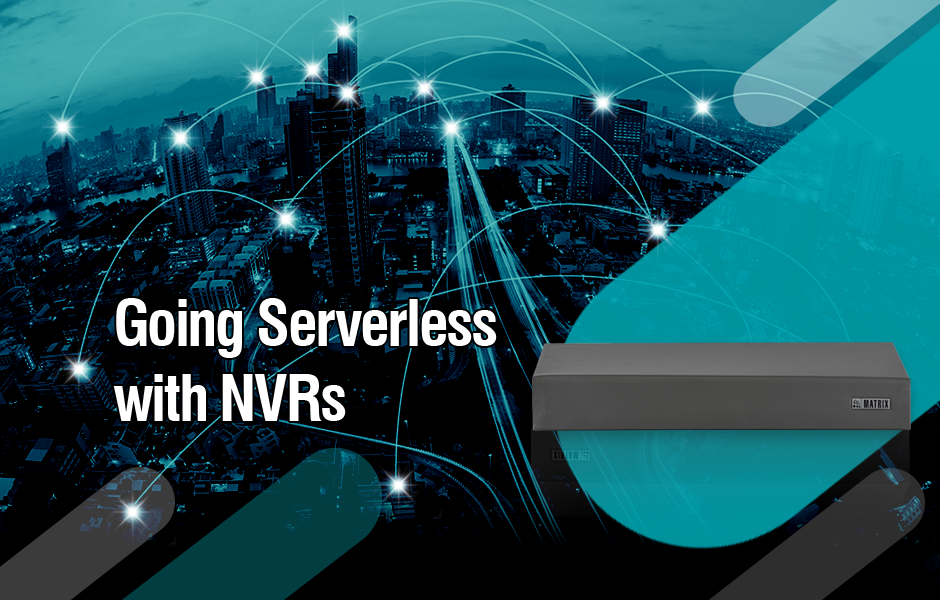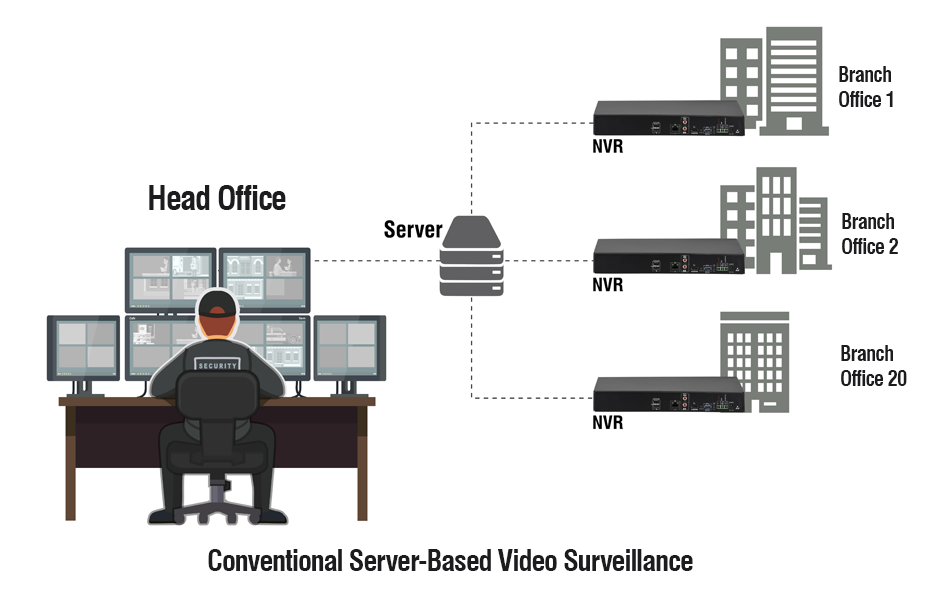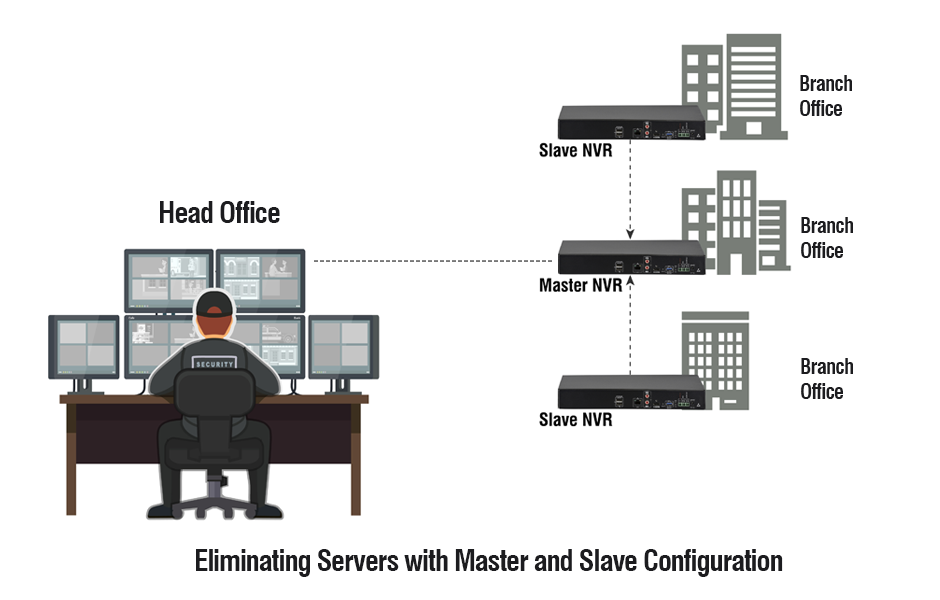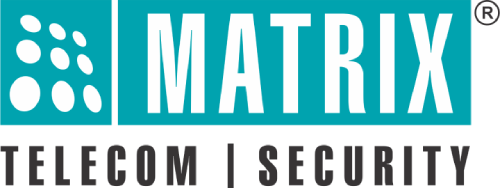
Today, a CCTV camera can be spotted at every nook and corner where you go. Sure, these CCTV cameras level up security, but the greater the number of cameras, the greater the complexity to manage them. Thus, having a comprehensive system that can centrally manage video footage has become the need of the hour.
A centralized video surveillance solution allows organizations to seamlessly integrate and monitor footage from multiple cameras at multiple locations, providing real-time oversight and control. This enables you to take quick action against potential crimes and thefts. Thus, it is a top concern for organizations that are looking to protect their assets and ensure the safety of their employees, customers, and visitors.
On top of that, it acts as an invaluable tool to optimize operations, boost efficiency and improve the productivity of your organization, thereby having a significant impact on the brand image.
And all of this – with the much-needed peace of mind.
The Role of Servers in Centralized Video Surveillance Systems
With the advancements in technology, the picture quality offered by surveillance cameras is at par with that of a high-end smart TV. Owing to the high-resolution video footage, the surveillance system – consisting of cameras and Network Video Recorders (NVRs) has to process a large volume of data at high speeds.
Now, just imagine you have to centrally monitor hundreds and thousands of cameras spread across the globe. In a conventional server-based video surveillance system, video data from various multi-location cameras are sent to the NVRs. The NVRs then transmit the data to a central server from where it is monitored using Video Management Software(VMS).
The use of a central server in a surveillance system adds an additional layer of complexity. Not only must the cameras and NVRs be managed, but servers must also be managed and configured to ensure security and efficiency. In addition to the initial cost of a server, one has to bear the ongoing expenses of maintaining the server’s operating system.
Complexities in a Conventional Server-Based Video Surveillance Solution
- Cost: Setting up and maintaining a server-based video surveillance system can be expensive, as it typically requires the purchase of hardware and software, as well as ongoing maintenance and support.
- Complexity: Server-based video surveillance systems can be complex to set up and manage, particularly for organizations that are not familiar with server infrastructure and network architecture.
- Security: Server-based video surveillance systems rely on a central server to store and manage video footage, which can make them vulnerable to security breaches if the server is not properly protected.
- Downtime: If the server fails or experiences technical issues, the entire video surveillance system may be unavailable until the issue is resolved.
- Integration: It may be difficult to integrate a server-based video surveillance system with other security systems or applications.
Eliminating Servers with NVRs: The Master and Slave Configuration
To centrally view live streams of multiple locations, you need Video Management Software (VMS) in addition to a dedicated high-end server. The VMS installed on the central server is specifically designed to meet the diverse needs of large enterprises that have multiple remote sites connected to a central location. However, the entire system becomes expensive and too difficult to operate because you have to set up separate monitoring stations and hire personnel to monitor the servers.
But what if there was a way to eliminate servers altogether and make centralized video surveillance more cost-effective and efficient?
Currently, various companies in the market offer technologically advanced solutions that completely eliminate the need for a server. One such solution is the use of a cascading feature in a video surveillance system. This feature allows a large number of cameras to be connected over a network of NVRs via the Master and Slave configuration.
The master NVR works as a central hub responsible for storing the video footage from all the multi-location cameras and provides access to it when needed. The slave NVRs are secondary devices that provide additional storage capacity or distribute a load of processing video streams across multiple devices.
Let’s say, your organization has various multi-location offices spread across the globe. You want the live streaming of all the branch offices from your head office.
In a traditional server-based video surveillance system, video footage captured by cameras is first streamed to the NVRs located in the branch office. This footage from the NVR is then sent to a central server. The central server then sends this video footage to the head office where it is viewed on the VMS. Here, the central server acts as a connecting bridge between the NVRs at the branch office and the VMS at the head office.

When using the cascading feature, the master NVR performs all the functions of the central server without compromising on speed or accuracy. The master NVR located at the head office acts as the primary NVR that controls and manages the video surveillance system. The slave NVRs located in the branch offices act as secondary NVRs that capture and store video footage.
Now, the cameras in the branch offices stream their footage to the corresponding slave NVR first, which then sends the footage to the master NVR in the head office. Here, the master NVR can control the cameras and settings of the slave NVRs, allowing for centralized management and control of the entire video surveillance system. This eliminates the need for an extra layer of server, as the master NVR is solely responsible for the functions of the server.

The cascading feature allows you to have a versatile and flexible architecture. You can have multiple masters and multiple slave NVRs depending on your needs.
Considering another scenario, your partner at some other location wants to access the clips of your branch offices simultaneously. In this case, two NVRs act as master NVRs, and the rest work as slave NVRs.
Cascading allows you to easily control viewer rights, for example, only personnel in the head office will be able to access all the cameras in the branch offices, whereas the personnel in the branch office will only get access to the cameras located in their office.
Thus, the master and slave configuration allows for the centralization of video footage storage and management, giving organizations complete control over their video surveillance system from a single location.
Why You Should Consider Cascading in NVRs Now
- Simplicity: Installing and maintaining servers requires a strong technical background, while NVRs can be set up quickly and are easy to maintain. NVRs are more convenient to manage and cause less hassle compared to servers.
- Improved performance: By distributing a load of processing video streams across multiple NVRs, it is possible to improve the overall performance of the system. This can help to reduce the strain on any single device and improve the reliability of the system.
- Flexibility: A master and slave configuration allows for flexibility in terms of adding or removing NVRs as needed. If additional storage or processing power is needed, it is possible to add additional slave NVRs to the system. If a device fails or is no longer needed, it can be removed without affecting the overall operation of the system.
- Centralized management: Cascading allows for centralized management of the video surveillance system from a single location. This can make it easier to view and manage the footage from all of the cameras, spread across the globe.
To Sum Up
Cascading in NVRs is ideal for centralized monitoring. Not only does it eliminate server costs, but it also makes managing the entire video surveillance system hassle-free.
With Matrix NVRs, you can connect up to 20 NVRs and 1000+ cameras on a single platform. Moreover, Matrix NVRs come with an in-built VMS which means you don’t have to buy it externally, thereby saving costs. This gives you much-needed flexibility, scalability, and security, which is beneficial for any organization with multiple locations.
Matrix has been providing security solutions for over three decades for various businesses. To know more about our Security Systems speak to experts on our toll-free number 1800 258 7747 or write to us at Inquiry@MatrixComSec.com.

